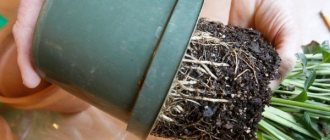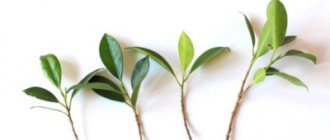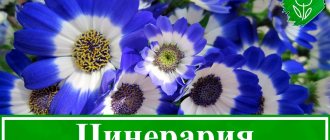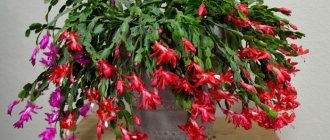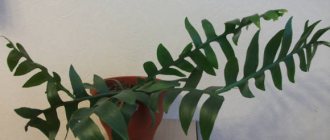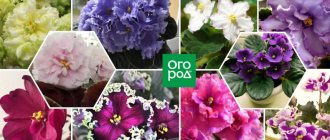And it is not surprising that, despite the extreme capriciousness, delicacy and even toxicity, this culture belongs to the group of the most fashionable flowering plants. For its grace and abundant flowering, it is called a competitor to violets, and its bright, very dense foliage will easily make it the most important decoration of any, even the most modest, interior.
This flower is the most prominent member of the Solanaceae family. This herbaceous perennial with evergreen leaves and lush flowering is native to the Antilles and South America. In its natural habitat, brunfelsia can grow up to 3 meters in height, but when cared for at home it barely reaches 40-50 cm. Its leaves are elongated, leathery, dense green in color, matte. Sitting on short petioles, they create a lush crown.
Description
A herbaceous perennial with evergreen foliage belongs to the Solanaceae family. This is the closest relative of eggplants and tomatoes. At home, its height reaches 0.5 meters, while in nature it grows up to three meters.
The erect stem branches from the very base. The leaf blades are large, leathery, dark green, cold in color. Attached to the stem on small petioles. The bark is grayish-brown. The root system is well developed, powerful and branched. Over time, the roots begin to become woody.
The plant is characterized by colorful flowering. The flowers are very similar to gentian, collected in inflorescences of ten pieces. They look modest and elegant, wide open. They look striking in contrast with the foliage. Rare species have a stronger aroma than others. It contains sweet notes and spring freshness.
The flowering period begins in February and continues until early summer. Flowers open unevenly, so on the same shrub they can be of different colors. The lifespan of each specimen is short - only 2-3 days.
Avoid getting the juice on your skin, as all parts of the perennial are poisonous. When working with it, it is important to follow safety precautions. Particularly dangerous are the orange fruits that ripen on the bush.
Origin
Brunfelsia is called American because its homeland is South America, where the plant grows the size of a tree.
At home, you can grow the plant in a pot. Brufelsia is also called manaka.
Belongs to the nightshade family and is a poisonous plant! Previously, wild Indian tribes processed the plant and prepared a psychotropic drug from it for use in pagan rituals by shamans.
Brunfelsia received its name in honor of the botanist Otho Brunfels, a colleague of Carl Linnaeus. And although the plant grows rather slowly, it can sometimes reach 5-7 meters in height.
There are about 40 species in this genus, but the low-growing Brunfelsia pauciflora is suitable for growing at home. Its flowers are dark purple at the beginning and white at the end of flowering. The disadvantages include the fact that this type of plant does not smell when it blooms.
Watering and humidity
The plant loves water, so regular watering is essential. But keep in mind that excess liquid is unacceptable, it will lead to damage to the flower.
In winter, when manaka is dormant, the amount of water needs to be reduced even more. Since the flower loves acidic soil, we recommend adding a few drops of lemon juice to the water before watering.
Tropical forests provide above-average humidity levels. If this indicator is too low in the room, place a container of water near the pot.
Brunfelsia Photos
Beneficial features
In the process of studying the plant, scientists found many useful medicinal properties, these are:
- helps to activate the body's lymphatic system;
- has an analgesic and antibacterial effect;
- helps relieve high fever;
- has an anti-convulsant effect;
- helps cleanse the liver.
Brunfelsia grows well at home even in a dark room, it will simply bloom less and emit less fragrance. It is important not to place the plant in direct sunlight, otherwise the leaves may fall off.
Trimming
Brunfelsia is easy to shape and can take the form of a tree or bush. You can trim the shoots of the plant only after flowering - at the beginning of summer or at the end of spring. In order for brunfelsia to bloom more luxuriantly, you need to cut the branches to half their length.
Read with us about methods of fern propagation.
How to properly transplant a monstera during the propagation process? The answer is here.
Caring for an indoor cordilina flower https://sad-doma.net/houseplants/decorative-leaf/lozhnye-palmy/kordilina-uhod.html tips for gardeners.
Poisonous properties
Brunfelsia is extremely poisonous. Moreover, all parts are toxic.
Particularly dangerous are small fruits like miniature orange tomatoes. Keep it away from children and pets.
IMPORTANT: Do not ignore protective gloves when in contact with the plant. Its juice, if it gets on the skin, can have a bad effect on the body.
Brunfelsia is a fragrant and beautiful representative of the flora. She cannot be called unattractive, because she will captivate with her magnificence. But beauty will have to be paid for with special care.
If you are willing to tinker with the plant, it will become a decoration in your home and will live with you for a long time.
Species and varietal diversity of Brunfelsias
Today, in indoor culture, one type of Brunfelsia is most widespread - the few-flowered one (Brunfelsia pauciflora). Compact, easy to mold and less capricious, it adapts better to indoor conditions and is more durable. It is her appearance that is considered typical for brunfelsias. Many attractive varieties have been bred on the basis of the few-flowered Brunfelsia:
- dark purple form of “Makranta” with flowers up to 8 cm in diameter;
- light purple form "Floribunda" with a white eye;
- purple-flowered variety 'Eximia'.
In addition to the few-flowered variety, larger species are occasionally found on sale.
The most successful option for the home is Brunfelsia pauciflora, which is most often found in indoor floriculture. It is small in size and characterized by year-round flowering of the bush. However, there are few flowers, and this distinguishes the described plant from other varieties.
Other types of brunfelsia suitable for home cultivation include the following:
- Large-flowered (or cup-shaped Francis) (Brunfelsia latifolia) is the most beautiful variety, presented in the form of a small shrub, up to 1 m in height. When young, the stem is always green and very smooth to the touch, but with age (about 3–4 years after planting) a flaky dark yellow bark forms on it. A few lanceolate leaves are arranged on the stem in an alternating order and are supported by solid short petioles. The lower part of the leaf blades is painted light green, but the upper part always has a more saturated dark green color. Sky-blue flowers are single (each 4–5 cm in diameter) or united in small loose clusters. Faded specimens turn blue-violet. Flowering begins in May and continues until the end of summer.
- Broadleaf (Brunfelsia latifolia) - characterized by wide lanceolate dark green leaves and blue flowers, which change color to white already on the 4th day after appearance. They are formed by oval, wide-open petals, which add elegance to the plant.
- Australian is an excellent option for planting in home greenhouses or gardens with sufficient free space. With a relatively small size, this variety of brunfelsia produces large flowers, up to 6 cm in diameter. All of them consist of five purple petals, which perfectly complement the green, pointed leaves.
- American (or “night beauty”) (Brunfelsia amiricana). This variety differs from the previous ones in the night-time formation of a persistent floral aroma. At first, the flowers are painted white, a little later they become creamy, and just before they dry out they acquire a yellowish color. The leaf blades of the Americana species are rich green in color, narrowed towards the petiole, widened in the middle part and pointed at the very end.
- Single-flowered - one of the largest representatives of the genus in question, characterized by thickened dark green leaves reaching a length of 10 cm. Single flowers grow up to 2.5–3 cm in diameter and during the entire time they are on the bush they change their color from purple or light blue until almost white.
- Few-flowered Francis (Brunfelsia pauciflora) is most often chosen for growing at home. The medium-sized shrub has bright green oval leaves. The plant blooms in early spring, but under favorable conditions you can observe the appearance of corollas all year round. A distinctive feature of the species is the voluminous umbrella inflorescences, due to which the leaves are often not visible.
- The southern plant variety (Brunfelsia australis) is one of the rarest. The bush is very compact (50-60 cm in length and width), while the flowers are large in size. Young inflorescences, painted dark purple, fade in a few days and become almost white.
- Brunfelsia lactea. The plant has a shrubby or tree-like growth form. Its height varies between 1.2–7 meters, the trunk measures 10 cm in diameter, covered with light brown bark. The leaf blades are oval or obovate in shape, the surface is leathery, and painted dark green. Leaf length is 5–15 cm, width is up to 2.5–6.5 cm. The flowers are arranged singly, painted in snow-white or light yellow tones, fragrant. The corolla is 5–7 cm long, 6 cm in diameter, and has 5 rounded petals. The ripening fruit is purple or light brown in color, in the shape of a fleshy berry, reaching a diameter of 2.5 cm.
- The species (Brunfelsia undulata) is characterized by very dark, narrow leaves with a glossy surface and snow-white flowers with carved edges.
Transfer
For good health, Brunfelsia needs loose and nutritious soil. mixture works well :
- 2 shares of leaf soil;
- 2 shares of turf land;
- 1 share of peat;
- 1 share of coarse sand.
You can also buy ready-made rose substrate The planting container should be deep and voluminous. A thick layer of drainage is required at the bottom of the pot.
be replanted every year immediately after the dormant period. Starting from the age of 4, the plant needs to be replanted every 3 or 4 years. Moreover, every winter it is necessary to change the top layer of soil.
Why is Brunfelsia called the Yesterday-Today-Tomorrow flower or the Morning-Day-Night flower?
The flowers are initially purple or blue, turning white after a few days. They have a pleasant delicate aroma. Flowers do not bloom at the same time, so on one plant you can see flowers of different shades - from deep purple to white. For this feature, brunfelsia is called “yesterday-today-tomorrow” or “morning-day-night”.
In indoor culture, the most common is Brunfelsia pauciflora, a slow-growing shrub up to 1–1.5 m high (in nature up to 3 m). The leaves are 8-10 cm long, entire, dark green, matte, leathery. Flowers are up to 5 cm in diameter, collected in 2-10 pieces in few-flowered inflorescences.
Brunfelsia americana, lactea and other species for indoor growing
| View | Leaf shape and size | Flowers |
| Americana | Ellipse up to 10 cm in length. | Creamy, aromatic, tube length up to 10 cm. |
| False-flowered | Oval up to 10 cm in length. | White, purple, no aroma. |
| Large-flowered | Oval, pointed. | White, purple with a diameter of up to 12 cm. |
| Uniflora | Oval up to 10 cm. | White, purple, up to 2.5 cm in diameter. |
| Dairy (lactea) | Oval, 5 cm long. | White, light yellow, fragrant, 5-7 cm long. |
Reproduction
Brunfelsia is propagated by apical cuttings and sowing seeds. However, there is some difficulty. You will need to purchase a heated propagator for seedlings. In both cases, in addition to humidity, it is necessary to ensure that the substrate temperature is similar to the tropical one. The temperature of the substrate, despite the humidity, should not fall below 25 °C. This is an absolute requirement. Otherwise, there is no point in undertaking reproduction.
Diseases and pests
Chlorosis is a disease that occurs when there is a lack of nutrients in the soil (iron, nitrogen, zinc, magnesium). The leaf blades turn yellow and their tips dry out. It is necessary to feed with iron chelate.
The leaves turn black along the veins - a fungal infection, the damaged parts of the plant are cut off, the flower is treated with copper-containing preparations, the soil is disinfected with copper sulfate (you can also spray the leaves and stems with it). The treatment is repeated 3-4 times with an interval of 10 days.
The color of the leaf blades is pale - the lighting is too bright.
The leaves turn yellow - due to waterlogging of the soil, the root system rots, which is why the leaves begin to turn yellow and fall off. Transplant brunfelsia urgently. Remove the affected areas of the roots, treat the cut areas with a fungicide, replace the substrate with a new one, and after replanting, water the flower with a phytosporin solution.
Insects
Among the pests that can be bothered are scale insects, aphids, and spider mites. Apply insecticide treatment.
- Scale insects are the main pest of the beautiful brunfelsia, which sucks the juices from the plant cells, causing the leaves and flowers to wither, turn pale and crumble. The only way to get rid of it is to treat the plant with insecticides.
- Spider mites are another pest that likes to attack flower crops. Its appearance can be determined by limp leaves and a thin web on the inside of the leaf. You can get rid of it using a soap solution, which you need to wash the leaves with, and then water the plant with a warm shower. If mites infested during the flowering period, spraying should not be carried out. Brunfelsia severely affected by this insect needs to be treated with an insecticide.
- Sometimes you can find aphids, whiteflies, and mealybugs on the plant. Slugs and snails can only be found when grown in a garden plot. In the event of the appearance of all these pests, it is necessary to treat the plants using special products sold in nurseries or specialized stores.
Choosing a location and lighting
The Brunfelsia flower prefers bright sunny color and its direct rays in the morning and evening.
The ideal place for brunfelsia is a warm and bright south-east window. The southwest is also good. On a southern window, the plant will need shading in the midday heat, and on a northern window it will feel bad due to lack of sun.
In summer, brunfelsia feels great at temperatures from +20 to +25 °C, and during the transition from autumn to winter and over the next two months - from +9 to +14 °C. This cool dormant period allows the brunfelsia to set flower buds.
Interesting facts about Brunfelsia
Some varieties of Brunfelsia, in particular large-flowered and single-flowered (Brunfelsia grandiflora, Brunfelsia uniflora) in the territories of its natural growth are usually added to the traditional drink Huasca, which causes hallucinations. The plant also has a neurotoxic effect, which can cause severe poisoning in livestock, since parts of brunfelsia contain a substance such as brunfelzimidine, the derivatives of which are pyrrole and gaunidine (1 - has a strong acidic effect, 2 - has fungicidal and bactericidal activity).
Since it is called “manaka” in its homeland, the plant owes this name to an old legend. This was the name given to the most beautiful girl in the Brazilian Tupi tribe, and she loved most of all these blue flowers blooming on the bushes. She was the first woman to brew a potion from tender buds that helps with unhappy love. After some heat treatment, Brunfelsia, like many plants from the nightshade family, can be used as a psychotropic drug. Therefore, shamans in the tribes of South America or the West Indies revered the plant as sacred and used it in magical rituals.
Attention!!! Brunfelsia is considered a highly poisonous plant, so when caring for it you will need to take certain safety measures, especially when it comes to being in rooms where there are small children or pets. This is due to the fact that the fruits ripening on the bush, which in their outlines resemble small “tomatoes”, colored orange, containing multiple seeds. It is these parts of the plant that pose particular danger.
In Brazil, Brunfelsia has a very incomprehensible name: “yesterday-today-tomorrow” or “morning-noon-night”. Naturally, this is incomprehensible to a person who has never encountered a flower. But everything is explained by the rich color palette of various shades of lilac and violet colors that decorate the petals of multiple buds; there are so many of them that sometimes the foliage is completely hidden behind the abundance of flowers.
They say that the phrase that has become a kind of motto of the plant is: “Don’t think about yesterday - it will make you cry. Don't think about tomorrow - it will make you worry. Live and think about today - it will make you laugh! ”, came up with one gardener who took just one look at the multiple Brunfelsia flowers covered in different color shades.
Home care
Brunfelsia is a demanding plant, probably because our latitudes are not its natural habitat. Caring for it is quite a troublesome task.
It is interesting to read about royal begonia.
Watering
The need for frequent watering exists during the active growth phase and during flowering. At this time, you need to water your green pets 2-3 times a week as the top layer of soil dries out. In winter, when the plant is dormant, it needs to be watered less often - once a week, since the root system does not have time to absorb all the water and the process of rotting may begin.
It is better to settle water for irrigation so that harmful impurities settle. You need to water it with soft water at room temperature in small portions - then the liquid does not stagnate in the pot.
Top dressing
Abundant flowering of brunfelsia is achieved by applying complex fertilizing. From mid-spring to mid-autumn, at least once a week you need to feed it with fertilizers for flowering plants. You can also use a universal liquid fertilizer, diluting it in half with water. During winter dormancy, fertilizers are applied once a month.
Find out also what and how to feed indoor plants.
Trimming
Pruning is essential to keep the plant looking beautiful. The process is carried out immediately after the end of flowering before the onset of the dormant period. All branches are cut to a third or half the length to form a crown of the correct shape, and the oldest shoots are also removed. This way, the growth of new branches is stimulated and the foundation is laid for the formation of buds for the next flowering season.
If the bush begins to lose shape during the active period of growth and flowering, its shoots can be pinched at the top.
Transfer
To replant the bush, wait until the end of the flowering phase and the onset of the dormant period. In this state, the flower will normally tolerate a change of environment. A young bush can be replanted once a year, and an adult one only after 2-3 years.
Important! Changing the substrate or pot is carried out only when such a need arises, and not “for growth”. There is no need to stress the plant unnecessarily.
During transplantation, it is necessary to ensure a high-quality drainage layer and drainage holes in the new “place of residence”.
The substrate is suitable sour or slightly sour. It is better to use the following types of mixtures in equal proportions:
- turf;
- leafy;
- coniferous;
- sandy
It's also a good idea to add some bone meal to the mixture.
Video
Sources
- https://flowers-home.info/brunfelsiya-uhod-vyrashhivanie-v-domashnih-usloviyah-razmnozheniya/
- https://tsvetem.ru/tsveti_v_dome/brunfelsiya-uxod-v-domashnix-usloviyax.html
- https://kachestvolife.club/rasteniya/brunfel-siya-vidy-i-sorta-posadka-i-uhod-v-domashnih-usloviyah
- https://komnatnyecvety.ru/brunfelsiya/
- https://selo.guru/rastenievodstvo/derorativ/brunfelsiya.html
- https://www.botanichka.ru/article/ekzoticheskaya-brunfelsiya/
- https://CampusMpei.ru/sad/brunfelsiya-uhod-v-domashnih-usloviyah-2.html
- https://sad1rzd.ru/sad/brunfelsiya-monako.html
- https://kubus-expo.ru/sadovodstvo/komnatnyj-tsvetok-brunfelsiya-soderzhanie-i-uhod-v-dome.html
- https://chto-posadit.ru/tsvetok-brunfelsiya-uhod-v-domashnih-usloviyah-razmnozhenie-cherenkami-peresadka-i-obrezka/
- https://www.supersadovnik.ru/text/brunfelsija-1009255
- https://floral-house.ru/tsvetushchie/brunfelsiya-malotsvetkovaya.html
- https://tutknow.ru/garden_and_orchard/7024-brunfelsiya-pravila-vyraschivaniya-v-domashnih-usloviyah.html
